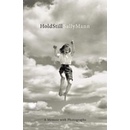Hold Still by Sally Mann Published: 2016 Read from: 09 Mar to 07 Apr My rating: 🌟 🌟 🌟 🌟 🌟
Sally Mann is a photographer of some notoriety. She is also, it turns out, an amazingly good writer able to create word pictures every bit as nuanced and beguiling as her picture pictures. An interesting question is whether, had she not been a renowned photographer, we would ever have learned what a fine writer she is. Would she have been prompted to write her memoir had she not been invited to give the Massey Lectures in the History of American Civilization at Harvard?
In a way that's a fatuous question and one that doesn't affect my judgement of the book. I don't even know why I should be so surprised that a person can be an artist in two such distinct forms. Hold Still sees Sally Mann reflecting on her life, artistic and otherwise, aided by an attic full of memorabilia from both sides of her extraordinary family. It's hard to single out any specific sections as being more interesting. Her early, wild life; the controversy about Intimate Relations; the wildly different but equally fascinating histories of her parents; her attachment to the land.
I could go on and on, but perhaps the most eye-opening part, because I am so very ignorant,1 was the one where she deals squarely with race. I loved reading about Gee-Gee, the woman who looked after her, effectively brought her up and taught her about the realities of race. Most of all, in the chapter Who wants to talk about slavery?, the various people she is now photographing:
On my studio porch, I both reveal and invite vulnerability, gently, I hope, teasing open the doorway to trust, a doorway that leads from an immutable past to a future that neither Gee-Gee nor I would ever have imagined.
I haven't seen those pictures except as the small images that dot Hold Still and I hope to rectify that soon. But they make the point that the images in the book illuminate the words just as surely as the words illuminate the rest of Sally Mann's pictures, some of which I have seen, and I appreciate both better as a result.
p.s. I read this as a real, paper book, which means I took far fewer notes than I should have. So I can't find the quote about bad artists and good art. But I did snap a few truly choice passages that really struck me.
Before the invention of photography, significant moments in the flow of our lives would be like rocks placed in a stream: impediments that demonstrated but didn't diminish the volume of the flow and around which accrued the debris of memory, rich in sight, smell, taste, and sound. No snapshot can do what the attractive mnemonic impediment can: when we outsource that work to the camera, our ability to remember is diminished and what memories we have are impoverished.
This is so true for me. If I have a photo, I can barely remember any of the details, if I don't, I think I can remember some things, but could equally well be making that up.
The Japanese have a phrase for this dual perception: mono no aware. It means "beauty tinged with sadness," for there cannot be any real beauty without the indolic whiff of decay. For me, living is the same thing as dying, and loving is the same thing as losing, and this does not make me a madwoman; I believe it can make me better at living, and better at loving, and, just possibly, better at seeing. p 415
Sally Mann's thoughts about death and what to do with the dead mirror my own almost perfectly; confirmation bias again.
The greatest threat to that stability [of colonial society] was thought to lie in the possible recognition of common interests between poor whites and slaves. To prevent such a nightmare alliance from taking shape, the law, the pulpit, and the press joined forces to deepen the perceived differences between the races by convincing white colonists that they were naturally superior; that they, whatever their social rank, were, as [Edmund] Morgan put it, "equal in not being slaves." As a cynically encouraged moral disease, racism has had regrettable staying power and, no matter how we deny it, is still employed as a subtle but potent political and psychological tool. p 280
Nothing to add; plenty to learn.
| My review on Goodreads. | Buy it at an independent bookshop |
|---|
-
Becoming slightly less so, slowly, thanks also to listening to John Biewen's podcast series Seeing White on Scene on Radio. ↩
Webmentions
Webmentions
Webmentions allow conversations across the web, based on a web standard. They are a powerful building block for the decentralized social web.
If you write something on your own site that links to this post, you can send me a Webmention by putting your post's URL in here:

Comments